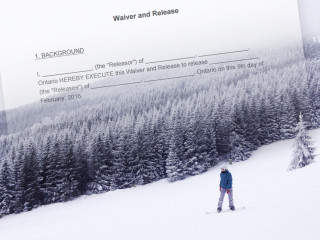MATERIAL FACTS
The Plaintiff, a paraplegic, was supplied with an electric wheelchair by the Defendant which subsequently caused pressure ulcers and the ultimate removal of his colon, by the friction caused by the metal control box on the wheel chair and his body. After a four-week jury trial, the Defendant was found liable for damages caused, but the Plaintiff was found to be 75% contributorily negligent. The result was that the Plaintiff was awarded $72,966.92 including PJI. In closing submissions, the Plaintiff sought an amount between $160,000 – $200,000 for general damages and over $700,000 for future care costs. Partial indemnity costs were submitted by the Plaintiff of approximately $260,000.
The Defendant’s R 49 offer to settle ($100,000) was better than the Plaintiff’s outcome at trial. The Defendant sought $139,049.96 in partial indemnity costs at 66% from the date of the offer to the end of trial. That was reduced to $128,500 by the Court reflecting partial indemnity rates at 60%. The bill of costs up to the R 49 offer to settle by the Plaintiff was approximately $152,460 and later reduced to $131,633 in partial indemnity costs by the Court at a rate of 60%. The Defendant concedes it should pay the Plaintiff’s costs up until the R49 offer to settle, but that they are still entitled to the remainder from the off-set of $109,000.00.
ISSUES
i. Was the Defendant’s R 49 offer ambiguous?
ii. Was the offer a bona fide and reasonable attempt to settle the litigation?
iii. Does the apportionment of liability reduce the Plaintiff’s costs?
BRIEF ANSWER
The costs payable to the Plaintiff and Defendant are effectively equivalent, and accordingly no costs are ordered in the result.
ANALYSIS
With respect to the Defendant’s R49 offer to settle, the Plaintiff argues that the offer was ambiguous and thus not entitled to recover trial costs. The Plaintiff indicates that the Defendant’s offer to settle is both global and non-severable, made to multiple plaintiff’s and does not meet the requirements of R49.10. further that the global offer is inherently inconsistent with the Plaintiffs’ interests and the rational for cost consequences citing Mayer v. 1474479 Ontario Inc., 2014 ONSC 2622.
Gomery J., instead relied upon the principles in Fragomenti v. Ontario Corp. 1080486 (2007), 81 O.R. (3d) 577 (S.C.J.) that:
It is clear that the sum offered is intended to include all the plaintiffs. There is no ambiguity in the wording of the offer, nor was it misleading. The only rational conclusion from its wording is that it was a package offer for the plaintiffs to divide up amongst themselves any way they saw fit. They rejected it not because it was confusing, but because they thought they could do better at trial. This is exactly what Rule 49.10 is intended to address.
These offers do not give rise to, in close knit families, concerns about leveraging one plaintiff against another. So long as the offer is ‘clear’ is it capable of meeting the requirements of R 40.10 D’Addario v. Smith, 2016 ONSC 4690, [2016] O.J. No. 3948 at [29].
With respect to the whether the Defendants offer to settle was a bona fide attempt to settle the matter, the Plaintiff argues that the R 49 does not trigger cost consequences because it was not a reasonable offer and did not represent any meaningful compromise on the Defendant’s part. Lawson v. Viersen, 2012 ONCA 25, 108 O.R. (3d) 771 at [20].
Gomery J., was required to apply Rule 50.09 in that parties are expressly prohibited from communicating statements made during pre-trials to the trial judge. The ‘reasonability’ quantum was founded, the Plaintiff submits, in what the pre-trial judge told counsel during the pre-trial conference. That was fatal to the Plaintiff’s argument. The jury’s award is the only value that a trial judge may take into consideration for the purpose of cost consequences.
Lastly, The Defendant argues that the trial judge ought to reduce the Plaintiff’s costs award by an amount equivalent to the degree of fault apportioned onto the Plaintiff Gallant v. Fanshawe College of Applied Arts & Technology, [2009] O.J. No. 5339 (S.C.J.) at [16-18].
Gomery J., however relied upon the analysis by Leach J., in Miller v. Her Majesty the Queen in Right of Canada, 2015 ONSC 2554, [2015] O.J. No. 2468 at [76-77] and the 4-part analysis in ascertaining whether a plaintiff’s costs should be discounted to reflect a finding of contributory negligence:
i. Whether the plaintiff’s own contribution to his injuries was minimal;
ii. Whether the plaintiff’s contributory negligence substantially contributed to the need for litigation;
iii. Whether addressing the plaintiff’s contributory negligence substantially increased the costs of litigation, because additional ordinary and expert evidence was required; and
iv. Whether the parties’ respective positions on the issue of contributory negligence prior to trial materially affected the chances of settlement.
Ultimately, the Court followed Miller and indicated that the Plaintiff’s contributory negligence did not substantially contribute to the need for litigation. It did not increase the cost of the action. No expert evidence was required on this issue. No additional witnesses were required on this issue. Lastly, that this issue did not prevent settlement as the Plaintiff’s own offer to settle was discounted by 50%.
Importantly Gomery J., identifies at [60] that:
The extent of Mr. Singh’s contributory liability is the only factor that weighs in favour of a commensurate reduction of his costs. I conclude that this factor alone does not, by itself, justify a drastic reduction to Mr. Singh’s cost recovery. The cost award already reflects the apportionment of liability. If the jury had not found Mr. Singh 75% liable, he would have beaten Shoppers’ settlement offer. As it is, Mr. Singh cannot recover any costs after August 23 and in fact must pay Shoppers’ costs. In these circumstances, imposing a further substantial discount of Mr. Singh’s cost recovery because of the finding of contributory liability would be neither reasonable nor fair.
CONCLUSION
At [72] Gomery J., concluded that:
Mr. Singh won his case, in that he succeeded on the issues of negligence, legal warranty and causation. On the other hand, the jury largely accepted Shoppers’ position on damages and concluded that Mr. Singh had the lion’s share of liability for them. As a result, the plaintiff obtained a less favourable result than he would have if he had accepted the defendant’s offer. The cost award must reflect this.
The Defendant was entitled to $128,500 – $138,633 in costs. The Plaintiff was entitled to $131,633 in costs. The Court set-off the costs in their entirety.













